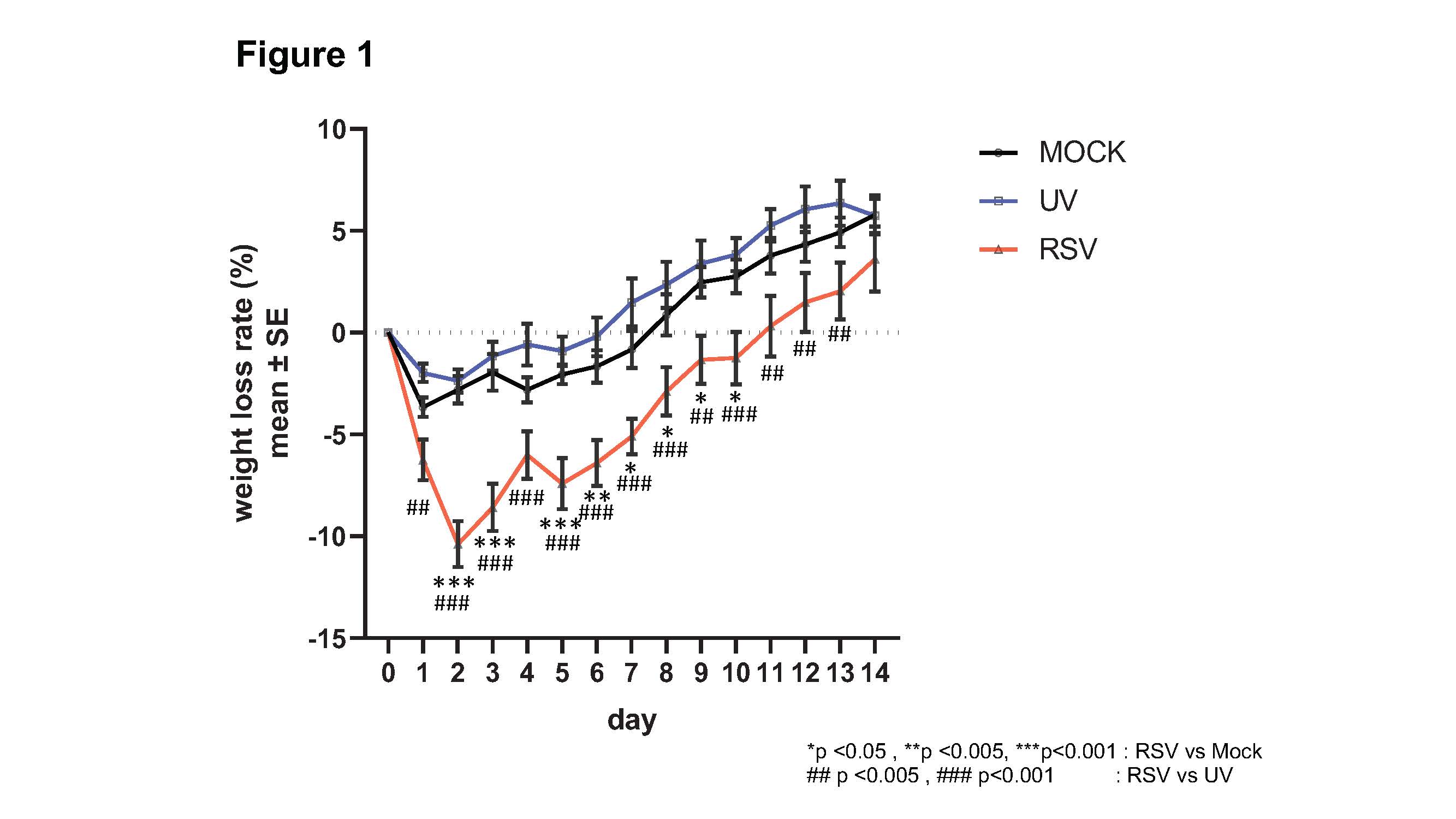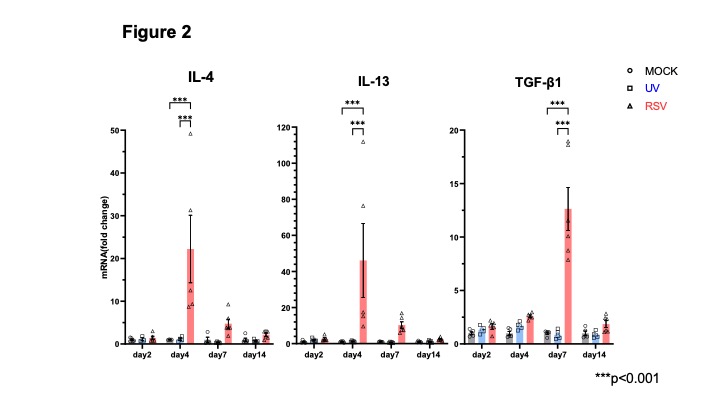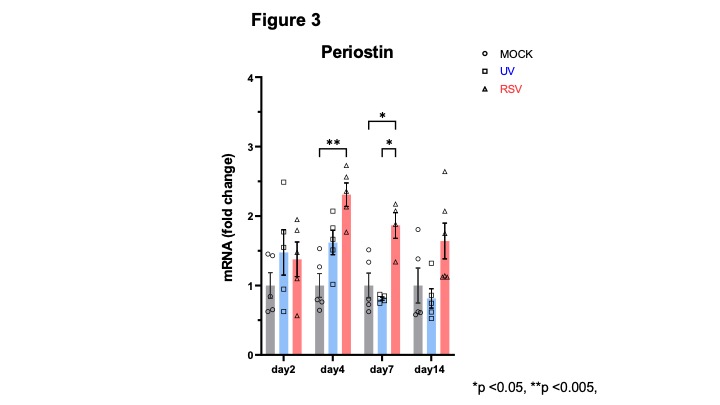Back
Background: Respiratory syncytial virus (RSV) is the leading cause of bronchitis in young children. Children with RSV bronchiolitis, severe enough for hospitalization, have a higher risk of developing recurrent wheezing, childhood asthma, or allergic rhinoconjunctivitis. Palivizumab have contributed to improvements in clinical outcomes of RSV infection compared with three decades ago. However, further investigation into the pathogenesis of recurrent wheezing and childhood asthma after RVS infection is still needed to ease the suffering of infants affected by RSV bronchitis. Periostin, identified as a promising biomarker involving asthma pathogenesis, is a matricellular protein whose expression can be induced by type 2 inflammatory cytokines IL-4 and IL-13. IL-4 and IL-13 stimulate the secretion of periostin from lung fibroblasts. In the current study, we hypothesized that periostin is associated with the pathogenesis of wheezing and asthma after RSV infection.
Objective: To evaluate the exact contribution of periostin in the pathogenesis and ventilation parameters in a mouse model of RSV.
Design/Methods: Human RSV strain A2 was propagated in Vero cells using serum-free medium and stored at -80℃. Mice (5wks old) were infected intranasally with 1×107 PFU /g in 100 ul serum free medium. Control and UV mice were sham infected with serum- free medium and UV irradiated RSV.
Lung samples were collected at 2,4,7 and 14 days post infection (dpi). RNA was extracted from whole lung homogenates using the mirVANA-RNA isolation kit ((Life technologies). 18s was used as normalized controls. Quantiative real-time PCR was performed using TaqMan Gene expression assay (Life technologies) for the following genes: IL-4, IL-13, TGF-β1, and postn.
At 1,2,3,4,5,6,7,8,9,10,11,12,13,14 days, body weight gain was measured and lung function (Penh (enhanced pause=(expiration time/relaxation time-1) ×(peak expiratory flow/peak inspiratory flow)) test was performed using plethysmography (emka science).
Results: BW in RSV infected mice compared with control and UV irradiated RSV infected mice was significantly reduced from dpi 1- 14 (Figure 1). Penh in RSV infected mice mice compared with control and UV irradiated RSV infected mice was significantly increased (Figure 2) at dpi 1,2,5,7,9. Lung periostin, IL-4 and IL-13 expression levels at dpi 4 were significantly increased in RSV infected mice. Lung TGF-β1 levels at dpi 7 were increased in RSV infected mice(Figure 3).
Conclusion(s): Periostin may be associated with the pathogenesis of RSV bronchitis and resurrent wheezing after RSV infection.



Infectious Diseases
Session: Infectious Diseases 3
131 - RSV infection alters mice lung periostin, IL-4 and IL-13 expression levels
Sunday, May 5, 2024
3:30 PM – 6:00 PM ET
Poster Number: 131
Publication Number: 131.2038
Publication Number: 131.2038
- HG
Hayato Go (he/him/his)
Associate professor
Fukushima Medical University
Fukushima Medical University
Fukushima, Fukushima, Japan
Presenting Author(s)
Background: Respiratory syncytial virus (RSV) is the leading cause of bronchitis in young children. Children with RSV bronchiolitis, severe enough for hospitalization, have a higher risk of developing recurrent wheezing, childhood asthma, or allergic rhinoconjunctivitis. Palivizumab have contributed to improvements in clinical outcomes of RSV infection compared with three decades ago. However, further investigation into the pathogenesis of recurrent wheezing and childhood asthma after RVS infection is still needed to ease the suffering of infants affected by RSV bronchitis. Periostin, identified as a promising biomarker involving asthma pathogenesis, is a matricellular protein whose expression can be induced by type 2 inflammatory cytokines IL-4 and IL-13. IL-4 and IL-13 stimulate the secretion of periostin from lung fibroblasts. In the current study, we hypothesized that periostin is associated with the pathogenesis of wheezing and asthma after RSV infection.
Objective: To evaluate the exact contribution of periostin in the pathogenesis and ventilation parameters in a mouse model of RSV.
Design/Methods: Human RSV strain A2 was propagated in Vero cells using serum-free medium and stored at -80℃. Mice (5wks old) were infected intranasally with 1×107 PFU /g in 100 ul serum free medium. Control and UV mice were sham infected with serum- free medium and UV irradiated RSV.
Lung samples were collected at 2,4,7 and 14 days post infection (dpi). RNA was extracted from whole lung homogenates using the mirVANA-RNA isolation kit ((Life technologies). 18s was used as normalized controls. Quantiative real-time PCR was performed using TaqMan Gene expression assay (Life technologies) for the following genes: IL-4, IL-13, TGF-β1, and postn.
At 1,2,3,4,5,6,7,8,9,10,11,12,13,14 days, body weight gain was measured and lung function (Penh (enhanced pause=(expiration time/relaxation time-1) ×(peak expiratory flow/peak inspiratory flow)) test was performed using plethysmography (emka science).
Results: BW in RSV infected mice compared with control and UV irradiated RSV infected mice was significantly reduced from dpi 1- 14 (Figure 1). Penh in RSV infected mice mice compared with control and UV irradiated RSV infected mice was significantly increased (Figure 2) at dpi 1,2,5,7,9. Lung periostin, IL-4 and IL-13 expression levels at dpi 4 were significantly increased in RSV infected mice. Lung TGF-β1 levels at dpi 7 were increased in RSV infected mice(Figure 3).
Conclusion(s): Periostin may be associated with the pathogenesis of RSV bronchitis and resurrent wheezing after RSV infection.



